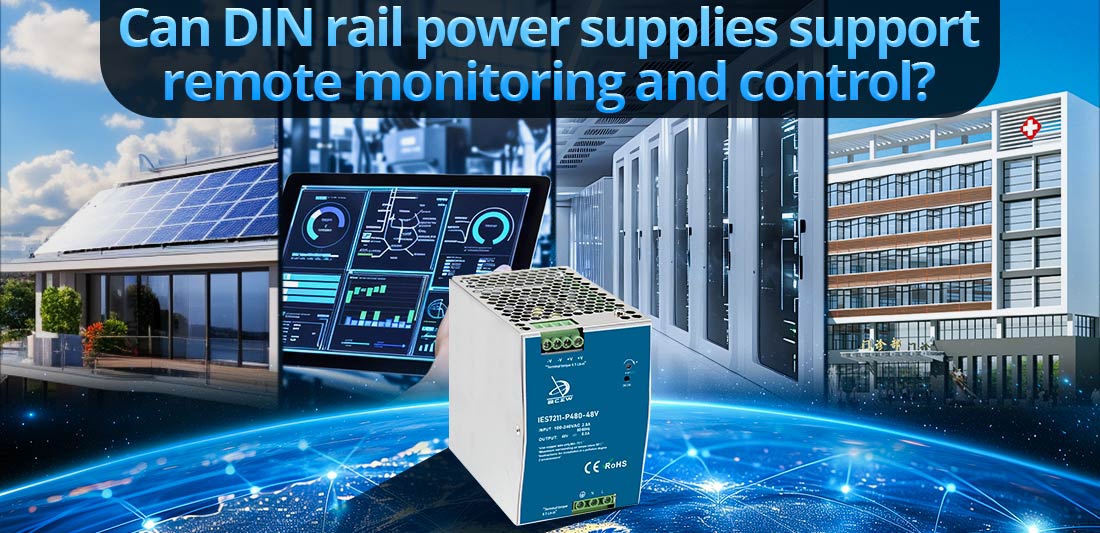
نعم، يمكن لمصادر طاقة السكك الحديدية DIN أن تدعم المراقبة والتحكم عن بعد، خاصة تلك المصممة للتطبيقات الصناعية أو تطبيقات الأتمتة المتقدمة. أصبحت هذه القدرات ممكنة من خلال واجهات الاتصال المتكاملة والميزات الذكية، مما يسمح للمستخدمين بمراقبة الأداء والتحكم في الإعدادات والاستجابة للمشكلات عن بعد. وفيما يلي شرح تفصيلي لكيفية عمل هذه الميزات وفوائدها:
1. ميزات دعم المراقبة والتحكم عن بعد
إمدادات الطاقة للسكك الحديدية DIN مع قدرات المراقبة والتحكم عن بعد تتضمن عادةً الميزات التالية:
1.1. واجهات الاتصالات
--- Modbus RTU / Modbus TCP: بروتوكول يستخدم على نطاق واسع في البيئات الصناعية، مما يتيح التكامل السلس مع وحدات التحكم المنطقية القابلة للبرمجة (PLCs)، وأنظمة التحكم الإشرافي والحصول على البيانات (SCADA)، وأجهزة الكمبيوتر الصناعية.
--- CAN Bus: شائع في الأتمتة الآلية والصناعية، فهو يسمح بالاتصال في الوقت الفعلي بين مصدر الطاقة ومكونات النظام الأخرى.
--- Ethernet/IP: يتيح الاتصال بالشبكات للوصول عن بعد، وغالبًا ما يُستخدم في تطبيقات إنترنت الأشياء الصناعية.
--- RS-485 أو RS-232: بروتوكولات اتصال تسلسلية لنقل البيانات بشكل بسيط عبر مسافات أطول.
--- SNMP (بروتوكول إدارة الشبكة البسيط): يستخدم في تكنولوجيا المعلومات والاتصالات لإدارة ومراقبة أجهزة الشبكة، بما في ذلك مصادر الطاقة.
1.2. تعديل المعلمة عن بعد
يمكن للمستخدمين ضبط المعلمات التالية عن بعد:
--- جهد الخرج والتيار: قم بضبط أو ضبط الجهد والتيار لتلبية متطلبات النظام المتغيرة.
--- إعدادات الحماية: قم بتكوين عتبات الجهد الزائد أو التيار الزائد أو الإغلاق الحراري لتعزيز سلامة المعدات.
1.3. مراقبة البيانات في الوقت الحقيقي
--- مراقبة مقاييس الأداء الرئيسية مثل الجهد والتيار واستهلاك الطاقة ودرجة الحرارة وظروف الخطأ.
--- معلومات حالة الوصول (على سبيل المثال، التشغيل أو الاستعداد أو الخطأ) للإدارة الاستباقية.
1.4. تسجيل الأحداث والتنبيهات
--- سجلات الأحداث: قم بتخزين البيانات التاريخية حول أداء مصدر الطاقة والأخطاء والأحداث التشغيلية لاستكشاف الأخطاء وإصلاحها وتحليلها.
--- التنبيهات والإشعارات: إرسال التنبيهات تلقائيًا عبر البريد الإلكتروني أو الرسائل القصيرة أو إشعارات النظام عند حدوث ظروف محددة مسبقًا، مثل التحميل الزائد أو ارتفاع درجة الحرارة.
2. كيفية عمل المراقبة والتحكم عن بعد
2.1. التكامل مع أنظمة التحكم
عادةً ما يتم دمج مصادر طاقة السكك الحديدية DIN التي يتم تمكينها عن بُعد في أنظمة أكبر باستخدام:
--- أنظمة SCADA: توفر منصة مركزية لمراقبة مصادر الطاقة والتحكم فيها إلى جانب الأجهزة الصناعية الأخرى.
--- PLCs وHMIs: تسهيل التحكم المحلي وتصور بيانات مصدر الطاقة.
--- بوابات إنترنت الأشياء: قم بتوصيل مصادر الطاقة بالمنصات السحابية للوصول عن بعد وتحليل البيانات.
2.2. أدوات البرمجيات
غالبًا ما توفر الشركات المصنعة برامج أو تطبيقات خاصة للإدارة عن بُعد. تتيح هذه الأدوات للمستخدمين:
--- عرض مقاييس الأداء في الوقت الحقيقي.
--- ضبط الإعدادات مثل جهد الخرج أو التيار عن بعد.
--- تلقي تشخيصات الأعطال وتوصيات الصيانة.
2.3. تكوين الشبكة
--- لتمكين الوصول عن بعد، يتم توصيل مصادر الطاقة بالشبكات الصناعية أو شبكات المؤسسات. يمكن للمستخدمين الوصول بشكل آمن إلى الأجهزة من خلال إعدادات الشبكة المحلية أو شبكات VPN للاتصالات عن بعد.
3. تطبيقات المراقبة والتحكم عن بعد
تعد الإمكانيات عن بعد مفيدة بشكل خاص في السيناريوهات التالية:
3.1. الأتمتة الصناعية
--- في خطوط الإنتاج الآلية، يضمن التحكم عن بعد بإمدادات الطاقة التشغيل السلس ويسمح بإجراء تعديلات في الوقت الفعلي لاستيعاب التغيرات في الآلات أو متطلبات الحمل.
3.2. أنظمة الطاقة المتجددة
--- بالنسبة لأنظمة مثل مزارع الطاقة الشمسية أو توربينات الرياح، تساعد المراقبة عن بعد في إدارة مواقع توليد الطاقة الموزعة، مما يضمن التشغيل الفعال والاستجابة السريعة للمشكلات.
3.3. الاتصالات
--- في مرافق الاتصالات، تسمح الإدارة عن بعد للمشغلين بمراقبة إمدادات الطاقة عبر مواقع متعددة، والحفاظ على توصيل الطاقة بشكل ثابت إلى المعدات الحيوية.
3.4. مراكز البيانات
--- تستفيد مراكز البيانات من التحكم عن بعد من خلال تمكين المراقبة المركزية لإمدادات الطاقة التي تدعم الخوادم ومعدات الشبكات، مما يضمن وقت التشغيل والموثوقية.
3.5. البنية التحتية الحيوية
--- في قطاعات مثل الرعاية الصحية أو النقل، تضمن المراقبة عن بعد التشغيل دون انقطاع للأنظمة الأساسية، مع التشخيص السريع وإمكانات استكشاف الأخطاء وإصلاحها.
4. فوائد المراقبة والتحكم عن بعد
--- زيادة موثوقية النظام: يؤدي الكشف المبكر عن المشكلات المحتملة إلى تقليل وقت التوقف عن العمل ومنع حالات الفشل.
--- الكفاءة المحسنة: تسمح البيانات في الوقت الفعلي بإدارة الطاقة واستخدام الطاقة على النحو الأمثل.
--- توفير التكاليف: يقلل الوصول عن بعد من الحاجة إلى زيارات الصيانة في الموقع.
--- قابلية التوسع: يمكن مراقبة مصادر الطاقة المتعددة والتحكم فيها من واجهة واحدة، مما يسهل إدارة الأنظمة واسعة النطاق.
--- السلامة والامتثال: يضمن التكوين عن بعد أن تعمل الأجهزة ضمن معايير آمنة وتلبية المعايير التنظيمية.
5. تحديد مصدر طاقة DIN Rail الذي يمكن التحكم فيه عن بعد
عند اختيار مصدر طاقة السكك الحديدية DIN للمراقبة والتحكم عن بعد، ضع في اعتبارك ما يلي:
--- بروتوكولات الاتصال: تأكد من التوافق مع شبكة التحكم الموجودة في نظامك (على سبيل المثال، Modbus، CAN، Ethernet).
--- تصنيف الطاقة: تأكد من أن مصدر الطاقة يلبي متطلبات الجهد والتيار للتطبيق الخاص بك.
--- دعم البرامج: ابحث عن النماذج التي توفر برامج سهلة الاستخدام للوصول والتكوين عن بعد.
--- المواصفات البيئية: تأكد من أن مصدر الطاقة يمكن أن يعمل في ظروفك المحددة (مثل درجة الحرارة والرطوبة).
6. الاستنتاج
تتميز مصادر طاقة السكك الحديدية DIN المزودة بإمكانات المراقبة والتحكم عن بعد بأنها متعددة الاستخدامات للغاية وتعزز أداء النظام وموثوقيته وكفاءته. تعتبر هذه الميزات ذات قيمة خاصة في تطبيقات الصناعة والطاقة المتجددة والاتصالات والبنية التحتية الحيوية، مما يتيح إجراء التعديلات والتشخيصات والإدارة الاستباقية في الوقت الفعلي. عند اختيار مصدر طاقة، قم بإعطاء الأولوية للتوافق مع بروتوكولات الاتصال الخاصة بنظامك وتأكد من أنه يلبي متطلباتك التشغيلية والبيئية.